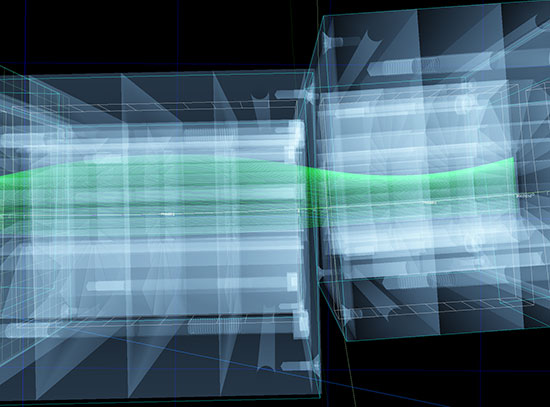Understanding the Growth of Ruddlesden-Popper Oxides
May 31, 2019
 enlarge
enlarge
The image shows the schematic structure of Sr2IrO4, Sr3Ir2O7, and SrIrO3. These materials, especially Sr3Ir2O7, are a unique playground to study exotic physics such as spin-flop transitions. Image credit: Appl. Phys. Lett. 114, 182401 (2019).
The Science
Scientists studied the synthesis window of Srn+1IrnO3n+1, Ruddlesden-Popper (RP) type oxides and provided a more accessible avenue to stabilize metastable materials.
The Impact
RP oxides provide a unique way to study exotic physics such as emergent phenomena. By studying these types of emergent materials, scientists can search for ways to engineer materials with specific electronic and magnetic properties.
Summary
Ruddlesden-Popper type Srn+1IrnO3n+1 compounds are a major focus of condensed matter physics, where the subtle balance between electron-electron correlation, spin–orbit interaction, and crystal field effects brings a host of emergent phenomena. Materials with this or similar combinations of properties are commonly referred as emergent materials and are interesting for potential new technologies.
For scientists, these materials, especially Sr3Ir2O7, are unique playgrounds to study exotic physics such as spin-flop transition. However, the epitaxial growth of Sr3Ir2O7 is still a challenging task because of the narrow growth window. Therefore, few samples for those studies are available to scientists.
In this study, the researchers studied the thermodynamic process during the synthesis of Sr3Ir2O7 thin films. They found that they could expand the synthesis window by mapping out the relationship between the thin film crystal structure and the gas pressure.
They used magnetic x-ray scattering measurements at the Integrated In situ and Resonant Hard X-ray Studies (ISR) beamline of the National Synchrotron Light Source II (NSLS-II), a U.S. Department of Energy (DOE) Office of Science User Facility located at DOE’s Brookhaven National Laboratory, in combination with a structural analysis and physical property measurements to draw the growth phase diagram as a function of oxygen pressure.
They also demonstrated that this growth window can be greatly expanded by introducing argon into the growth chamber. Their work thus provides a more accessible avenue to stabilize metastable materials and offers the potential to expand the number of available samples for studies on these materials.
Download the research summary slide
Contact
Junyi Yang
University of Tennessee
jyang43@vols.utk.edu
Lin Hao
University of Tennessee
lhao3@utk.edu
Jian Liu
University of Tennessee
jianliu@utk.edu
Publications
J. Yang, L. Hao, P. Nanney, K. Noordhoek, D. Meyers, L. Horak, J. Sanchez, J.-H. Chu, C. Nelson, M. P. M. Dean, J. Liu, “Epitaxial stabilization of Sr3Ir2O7 thin films” Applied Physics Letters 114, 182401 (2019). DOI : 10.1063/1.5092614
Funding
This work was supported by the Science Alliance Joint Directed Research and Development Program and the Organized Research Unit Program at the University of Tennessee; by the U.S. Department of Energy, Office of Basic Energy Sciences, Early Career Award Program under Award No. 1047478. J.S.; by the Air Force Office of Scientific Research Young Investigator Program under Grant No. FA9550-17-1-0217. Work at Brookhaven National Laboratory was supported by the U.S. Department of Energy, Office of Science, Office of Basic Energy Sciences, under Contract No. DESC00112704. This research used resources at the 4-ID beam line of the National Synchrotron Light Source II, a U.S. Department of Energy (DOE) Office of Science User Facility operated for the DOE Office of Science by Brookhaven National Laboratory under Contract No. DESC0012704. Part of characterization in this research was conducted at the Center for Nanophase Materials Sciences, which is a DOE Office of Science User Facility.
2019-16770 | INT/EXT | Newsroom








